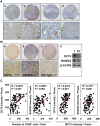Inflammation Promotes Expression of Stemness-Related Properties in HBV-Related Hepatocellular Carcinoma
- PMID: 26919045
- PMCID: PMC4769282
- DOI: 10.1371/journal.pone.0149897
Inflammation Promotes Expression of Stemness-Related Properties in HBV-Related Hepatocellular Carcinoma
Erratum in
-
Correction: Inflammation Promotes Expression of Stemness-Related Properties in HBV-Related Hepatocellular Carcinoma.PLoS One. 2017 Jan 26;12(1):e0171176. doi: 10.1371/journal.pone.0171176. eCollection 2017. PLoS One. 2017. PMID: 28125744 Free PMC article.
Abstract
The expression of cancer stemness is believed to reduce the efficacy of current therapies against hepatocellular carcinoma (HCC). Understanding of the stemness-regulating signaling pathways incurred by a specific etiology can facilitate the development of novel targets for individualized therapy against HCC. Niche environments, such as virus-induced inflammation, may play a crucial role. However, the mechanisms linking inflammation and stemness expression in HCC remain unclear. Here we demonstrated the distinct role of inflammatory mediators in expressions of stemness-related properties involving the pluripotent octamer-binding transcription factor 4 (OCT4) in cell migration and drug resistance of hepatitis B virus-related HCC (HBV-HCC). We observed positive immunorecognition for macrophage chemoattractant protein 1 (MCP-1)/CD68 and OCT4/NANOG in HBV-HCC tissues. The inflammation-conditioned medium (inflamed-CM) generated by lipopolysaccharide-stimulated U937 human leukemia cells significantly increased the mRNA and protein levels of OCT4/NANOG preferentially in HBV-active (HBV+HBsAg+) HCC cells. The inflamed-CM also increased the side population (SP) cell percentage, green fluorescent protein (GFP)-positive cell population, and luciferase activity of OCT4 promoter-GFP/luciferase in HBV-active HCC cells. Furthermore, the inflamed-CM upregulated the expressions of insulin-like growth factor-I (IGF-I)/IGF-I receptor (IGF-IR) and activated IGF-IR/Akt signaling in HBV-HCC. The IGF-IR phosphorylation inhibitor picropodophyllin (PPP) suppressed inflamed-CM-induced OCT4 and NANOG levels in HBV+HBsAg+ Hep3B cells. Forced expression of OCT4 significantly increased the secondary sphere formation and cell migration, and reduced susceptibility of HBV-HCC cells to cisplatin, bleomycin, and doxorubicin. Taking together, our results show that niche inflammatory mediators play critical roles in inducing the expression of stemness-related properties involving IGF-IR activation, and the upregulation of OCT4 contributes to cancer migration and drug resistance of HBV-HCC cells. Findings in this paper would provide potential targets for a therapeutic strategy targeting on inflammatory environment for HBV-HCC.
Conflict of interest statement
Figures




References
-
- Arndt W, Sandra K, Ina N, Henning S, Jochem K, Maria H, et al. Trends in epidemiology, treatment, and survival of hepatocellular carcinoma patients between 1998 and 2009: an analysis of 1066 cases of a German HCC registry. J Clin Gastroenterol. 2014;48: 279–289. 10.1097/MCG.0b013e3182a8a793 - DOI - PubMed
-
- Ajani JA, Song S, Hochster HS, Steinburg IB. Cancer Stem Cells: The promise and the potential. Semin Oncol. 2015;42: S3–S17. - PubMed
Publication types
MeSH terms
Substances
LinkOut - more resources
Full Text Sources
Other Literature Sources
Medical
Research Materials
Miscellaneous

